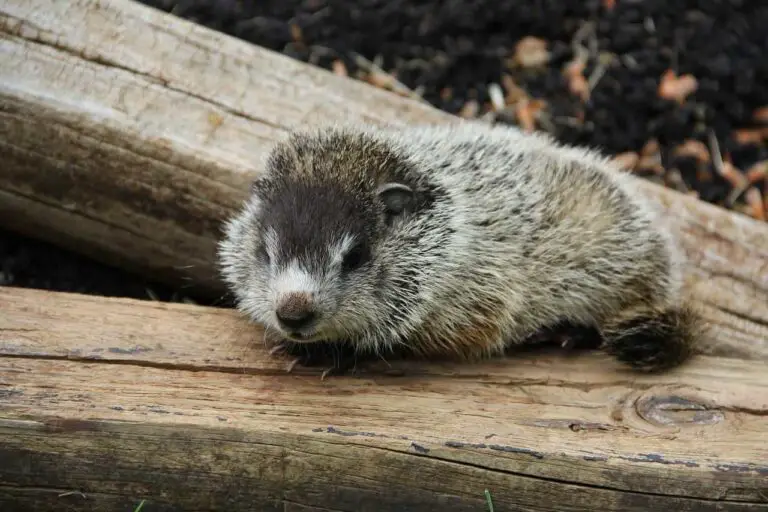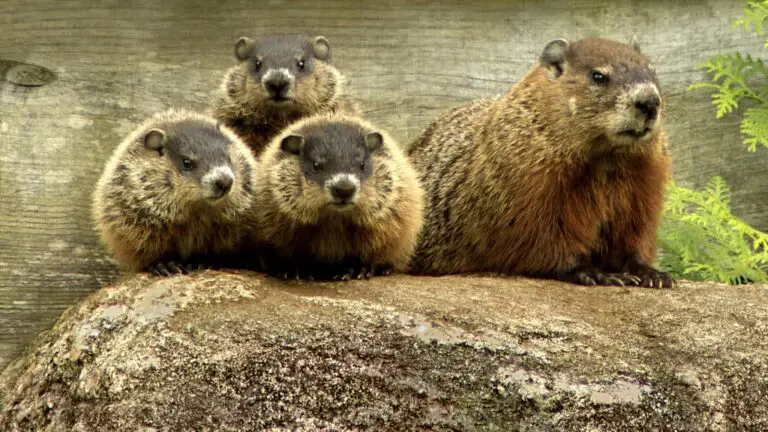Do Groundhogs Climb Trees? With Images & Videos

Generally, Groundhog or marmots, or woodchucks are found only in North America. They like forest areas that explode like open ground.
These days many people want to know “Can Groundhogs Climb Trees?” The answer to this question is Yes, Groundhogs are known as good climbers as well as swimmers.
Groundhogs have the strength to climb the tree also they are good swimmers.
The groundhogs are adult beaches that range in size from 15 to 25 inches in height and weigh between five and 13-14 pounds. Their bodies are compact and slender and are covered with dark gray hairs and a short tail. The lower legs have four legs and the front legs are also long, curved for digging holes.
Also, they are usually seen on the ground, groundhogs can climb trees and also be able to swim. These rodents often use areas where forests meet open spaces, such as fields, roads, or streams. Here they eat grass and plants as well as fruits and bark. Earth pigs harm many gardeners.
One of the fun facts is when we are afraid of someone or we feel that now our life is in danger, then we increase our speed or we also do the difficult work.
According to some researchers, it will be found that the name groundhog was dropped because I was expecting a groundhog to be on the ground, not the trees, and I can’t imagine a groundhog climbing a tree.
According to Wikipedia, wild boars, also known as tree species, occasionally climb trees when they are fleeing predators or when they want to assess their environment.
Groundhogs are cute creatures from the wild that can do tremendous damage to homeowners and gardeners.
Groundhogs can destroy crops, tear parts of roofs and vents, and spread disease. These animals have strong claws and will climb pillars and trees to reach the roof of the house, bird feeders, and other high-rise buildings. Prevent raccoons from climbing trees to avoid further material damage.
Do Groundhogs Climb Trees?
Why Would A Groundhog Climb A Tree? or Why would a woodchuck climb a tree?
There are might be despite their heavy physical appearance, groundhogs cater to swimmers and occasionally climb trees to avoid predators or when they want to survey their surroundings.
When panicked, they use a high-pitched whistle to warn the rest of the colony, hence the name whistle-pig.

Do Groundhogs Sleep In Tree?
Groundhogs are one of the few species that enter, true hibernation, and often build a separate winter tower for this purpose.
The tower is usually located in a forested or brushed area and is dug below the freezing line and stays at a constant temperature above freezing in the winter month.
According to some other sources, groundhogs also called woodchucks, sometimes climb trees when running away from animals or when they want to observe their environment.
Do Groundhogs Burrow Under Trees?
Groundhogs brows usually feature four exits around the main entrance. From the surface, the entrance to the tower often looks like a medium-sized hole leading to an underground network. Groundhogs holes can be located near trees, walls, or fences.

Do Groundhogs Chew Down Trees?
Although they chew or smell tree debris near their burrows, they do not cut down trees unlike their cousin, the American beaver.
Do Groundhogs Climb Houses Or Can Groundhogs Get Into Your House?
The feathers of a groundhog are brownish-brown, while squirrels are reddish-brown or almost gray feathers.
Groundhogs are outdoor rodents that build their underground homes. If a curtain or a large space is provided, squirrels will enter a house and live in the open walls or yard Earth does not spread disease.
Do Groundhogs Damaged Houses?
Groundhog Damage to Your Home or Foundation, The land is prone to flooding.
They can build caves under your house that are 45 feet long and 5 to 6 feet deep. These holes can cause serious damage. Ultimately, empty growth may lead to a failed foundation.
Can Groundhogs Climb Walls?
Groundhogs are known for their large, distinctive burrows. Marmots prefer to dig their burrows against structures that ensure air stability; In Michigan, this usually means around foundations, under warehouses and bridges, under brick pavers, terraces, and anything else with a concrete slab.
Do Groundhogs Climb Fences?
Fence them Groundhogs can jump over short fences and tunnels under others, so it is important to do it correctly. Buy chicken wire at least six feet high and five-foot poles. Attach the fence to the posts, except for the upper leg. Bend it away from your garden so that your countrymen do not climb over it.
Can Groundhogs Climb Wire Fences Or Can Groundhogs Climb Over Fences?
They can easily climb a well-supported fence, 3 meters high. Use this leaving the upper leg of the fence uninsured.
The fence will bend down at the top and it looks like you did a bad job installing it, but the advantage is that Mr. Groundhog won’t have the support to get up and up once he gets halfway there.
How High Should A Garden Fence Be?
The height of the fence should be at least 3 to 3.5 feet and preferably 5 to 5.5 feet above the ground. The second thing to know: not all marmots are born equal.
So to prevent the shy marmots from people, that plastic fence crushed in 15 to 25 minutes, with a few boxes of silver pie blowing in the wind, maybe all it takes.
How To Stop Groundhogs From Climbing Trees?
Dig an 18-inch deep ditch around the vegetable plot, build the fence at the bottom of it, then fill the ground at ground level. Make sure there are about two feet of wire above the ground to prevent them from climbing, and your crop should be secure.
Do Groundhogs Destroy Trees?
Their towers can be large 50 feet long with many sidewalks and multiple entrances. Because towers can be up to 5 to 6 feet deep, they can damage and dry out tree roots and weaken the foundations of buildings.
Despite their large appearance, groundhogs can swim and climb trees when they escape from wildlife or if they want to explore their area.
This Groundhog looked at us once and headed straight for the tree. He was not very happy with me trying to take a picture again and, although I asked well, he was not coming to discuss his negative thoughts of summer






